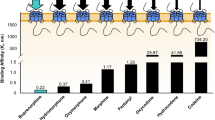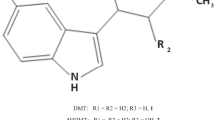Abstract
Methylxanthines produce a quasi-morphine withdrawal syndrome (QMWS) in opiate naive rats. Additionally, methylxanthine-induced suppression of conditioned behavior in rats is reversed by the alpha2 adrenergic agonist clonidine which also attenuates true opiate withdrawal and the QMWS. Therefore, the operant behavioral effect of 3-isobutyl-1-methylxanthine (IBMX) provide a model with which to study mechanisms involved in the expression of opiate withdrawal. In order to examine the role of serotonin (5-HT) in the rate-decreasing effects of IMBX on operant behavior, the 5-HT precursor 5-hydroxytryptophan, and 5-HT reuptake blocker fluoxetine were administered in combination with IBMX to rats performing a, fixed-ratio 30 operant for food reinforcement. Both drugs failed to reverse the behavioral suppression caused by relatively low doses of IBMX, suggesting that elevated 5-HT neurotransmission contributes to, rather than attenuates, the QMWS. The relatively selective 5-HT2 antagonists mianserin and pirenperone blocked the IBMX-induced suppression, whereas the classic 5-HT antagonist methysergide had no effect. The results indicate that the operant behavioral effects of IBMX and possibly the QMWS may be mediated by serotonergic mechanisms.
Similar content being viewed by others
References
Bellini D, Calvani M, Fenelli A, Le Pera G, Pietrini U, Sicuteri F (1982) Serotonin precursor (L-5-HTP) alleviates, the abstinence syndrome in morphine-heroin addicts. Int J Clin Pharmacol Res 11:127–133
Berkowitz BA, Spector S (1971) The effect of caffeine and theophylline on the disposition of brain serotonin in the rat. Eur J Pharmacol 16:322–325
Berkowitz BA, Tarver JH, Spector S (1970) Release of norepinephrine in the central nervous system by theophylline, and caffeine. Eur J Pharmacol 10:64–71
Berkowitz BA, Spector S, Pool W (1971) The interaction of caffeine, theophylline and theobromine with monoamine oxidase inhibitors. Eur J Pharmacol 16:315–321
Cardinali DP (1978) Effect of pentoxifylline and aminophylline on biogenic amine metabolism of the rat brain. Eur J Pharmacol 47:239–243
Clemens JA, Sawyer BD, Cerimele B (1975) Further evidence that serotonin is a neurotransmitter involved in the control of prolactin secretion. Endocrinology 100:692–698
Collier HOJ (1974) The concept of the quasi-abstinence effect and its use in the investigation of dependence mechanisms. Pharmacology 11:58–61
Collier HOJ, Cuthbert NJ, Francis DL (1981) Character and meaning of quasi-morphine withdrawal phenomena elicited by methylxanthines. Fed Proc 40:1513–1518
Colpaert FC, Janssen PAJ (1983) The head-twich response to intra-peritoneal injection of 5-hydroxytryptophan in the rat. Antagonist effects of purported 5-hydroxytryptamine antagonists and of pirenperone, an LSD antagonist. Neuropharmacology 22:993–1000
Colpaert FC, Janssen PAJ (1984) A possible alpha 2-adrenergic component in the in vivo activity of pirenperone. Eur J Pharmacol 103:169–171
Colpaert FC, Niemegeers CJE, Janssen PAJ (1979) In vivo evidence of partial agonist activity exerted by purported 5-hydroxytryptamine antagonists. Eur J Pharmacol 58:505–509
Colpaert FC, Niemegeers, CJE, Janssen PAJ (1982) A drug discrimination analysis of lysergic acid diethylamide (LSD): in vivo agonist and antagonist effects of purported 5-hydroxytryptamine antagonists and of pirenperone, a LSD-antagonist. J Pharmacol Exp Ther 221:206–214
Contreras E, Tamayo L, Quijada L, Munoz M (1980) Decrease of tolerance and physical dependence on morphine by drugs affecting brain serotonin. J Mol Biol 26:389–393
Dwoskin LP, Neal BS, Sparber SB (1983) Yohimbine exacerbates and clonidine attenuates acute morphine withdrawal in rats. Eur J Pharmacol 90:269–273
Francis DL, Roy AC, Collier HOJ (1975) Morphine abstinence and quasi-abstinence, effects after phosphodiesterase inhibitors and naloxone. Life Sci 16:1901–1906
Galloway MP, Roth RH (1983a) Clonidine prevents methylxanthine stimulation of norepinephrine metabolism in rat brain. J Neurochem 40:246–251
Galloway MP, Roth RH (1983b) Neuropharmacology of 3-isobutylmethyl-xanthine: effects on central noradrenergic systems in vivo. J Pharmacol Exp Ther 227:1–8
Graeff RG, Shoenfeld RI (1970) Tryptaminergic mechanisms in punished and nonpunished behavior. J Pharmacol Exp Ther 173:277–283
Grant SJ, Redmond DE (1982) Clonidine suppresses methylxanthine induced quasi-morphine withdrawal syndrome. Pharmacol Biochem Behav 17:655–658
Huang JT, Yano I, Takemori AE (1978) Effect of various central biogenic amine-modifiers and ambient temperature on the naloxone-induced jumping in morphine-dependent mice. In: Adler ML, Manara L, Samanin R (eds) Factors affecting the action of narcotics. Raven Press, New York, pp 495–509
Huidobro F, Contreras E, Croxatto R (1963) Studies on morphine. III. Action of metabolic precursors to serotonin and noradrenaline and related substances on the “abstinence syndrome” to morphine in white mice. Arch Int Pharmacodyn 146:444–454
Karasawa T, Furukawa K, Yoshida K, Shimizu, M (1976) Effect of theophylline on monoamine metabolism in the rat brain. Eur J Pharmacol 37:97–104
Kleven MS, Sparber SB (1987) Attenuation of isobutylmethylxanthine-induced suppression of operant behavior by pretreatment of rats with clonidine. Pharmacol Biochem Behav 28:235–241
Kleven MS, Sparber SB (1989) Morphine blocks and naloxone enhances suppression of operant behavior by low doses of 3-isobutyl-1-methylxanthine. J Pharmacol Exp Ther 248:273–277
Kleven MS, Dwoskin LP, Sparber SB (1983) Pharmacological evidence for the existence of multiple functional pools of brain serotonin: analysis of brain perfusate from conscious rats. J Neurochem 41:1143–1149
Lucki I, Nobler MS, Frazer A (1984) Differential actions of serotonin antagonists on two behavioral models of serotonin, activation in the rat. J Pharmacol Exp. Ther 228:133–139
Maruyama Y, Hayashi G, Smits SE, Takemori AE (1971) Studies on the relationship between 5-hydroxytryptamine turnover in brain and tolerance and physical dependence in mice. J Pharmacol Exp Ther 178:20–29
Neal BS, Sparber SB (1986) Mianserin, attenuates naloxone-precipitated withdrawal in rats acutely or chronically dependent upon morphine. J Pharmacol Exp Ther 236:1–9
Reinhard JF Jr, Galloway MP, Roth RH (1983) Noradrenergic modulation of serotonin synthesis and metabolism. II. Stimulation by 3-isobutyl-1-methylxanthine. J Pharmacol Exp Ther 226:764–769
Romandini S, Cervo L, Samanin R (1984) Evidence that drugs increasing 5-hydroxytryptamine transmission block jumping but not wet dog shakes in morphine-abstinent rats: a comparison with clonidine. J Pharm Pharmacol 36:68–70
Saminin R, Cervo L, Rochat, C, Poggesi E, Mennini T (1980) Reduction in the number of serotonin receptors in the brainstem of morphine dependent rats: relation to blockade of naloxone precipitated jumping by serotonin agonists. Life Sci 27:1141–1146
Schwartz AS, Eidelberg E (1970) Role of biogenic amines in morphine dependence in the rat. Life Sci 9:613–624
Sparber SB (1980) Use of learned behavior in testing for neurotoxicity. In: Gryder RM, Frankos VH (eds) The effects of foods and drugs on the development and function of the nervous system. HHS Publication (FDA), Washington, DC, pp 80–107
Sparber SB, Meyer DR (1978) Clonidine antagonizes naloxoneinduced supression of conditioned behavior and body weight loss in morphine dependent rats. Pharmacol Biochem Behav 9:319–325
Winer BJ (1971) Statistical principles in experimental design. McGraw-Hill, New York, pp 201–204
Wong DT, Horng JS, Bymaster, FP, Molloy BB (1974) A selective inhibitor of serotonin uptake: Lilly 110140,3-(trifluoromethylphenoxy)-N-methyl-3-phenylpropylamine. Life Sci 15:471–479
Yap CY, Taylor DA (1983) Involvement of 5-HT2 receptors in the wet-dog shake behaviour, induced by 5-hydroxytryptophan in the rat. Neuropharmacology 22:801–804
Author information
Authors and Affiliations
Rights and permissions
About this article
Cite this article
Kleven, M.S., Sparber, S.B. Modification of quasi-morphine withdrawal with serotonin agonists and antagonists: evidence for a role of serotonin in the expression of opiate withdrawal. Psychopharmacology 98, 231–235 (1989). https://doi.org/10.1007/BF00444696
Received:
Accepted:
Issue Date:
DOI: https://doi.org/10.1007/BF00444696




